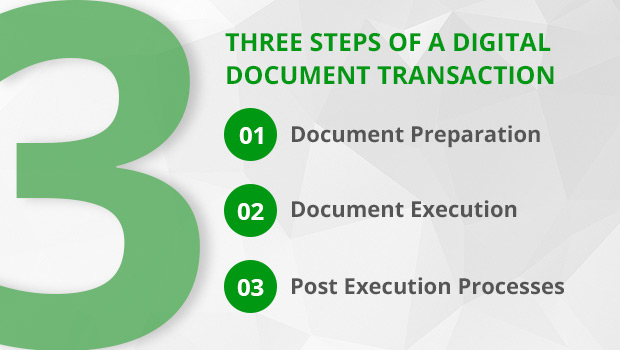- Published on
Three Steps to Transacting Documents Digitally
- Authors
-
-
- Name
- Michael Jones
-

Digital Transaction Management (DTM) helps to increase efficiency and productivity by simplifying paper-based processes and making them digital. The result is higher accuracy with fewer errors, improved controls, and customer satisfaction resulting from simplified process. When paper-based business transactions are converted into digital processes, we enjoy the benefits of efficiency, cost and time saving, and helping to save the environment by reducing the use of paper. Perhaps the biggest business benefit of going digital is the increase of productivity and the ability to monitor and track the progress of digital signature transactions at every step and in real time. There are three simple and easy steps to transacting a document digitally.
Document Preparation: This is the creation and preparation of digital documents that will control the transaction. In this first step, the process of preparing a document for signature could be as simple as filling out a form by hand or in digital format, or as complex as something that needs a formal document collaboration and compilation solution or document preparation service such as the one offered by paralegal staff. Once the document has been prepared, the second step in a digital document transaction is the execution of the document.
Document Execution: In the second step the documents, contracts, attachments, supporting documents, etc. are signed by one or more authorized parties in a particular sequence (workflow), filling in critical information. Security provisions are enforced and meta data is associated with signatory to ensure the authenticity and validity of each step of the digital documents’ transaction. Once a document set is completed by all parties, step three, is where the post execution process can begin.
Post Execution Processes: The post execution process includes securely storing the document, protecting it from tamper, alteration, and theft. In case of a dispute, the record must contain a detailed audit trail and chain of custody of the transaction for its legality and validity to be proven. Finally, only the authorized person should have access to and visibility into the document set. Post execution processes apply to both digital and printed versions of the documents.
Now that you understand the three steps of a digital document transaction it is important to understand why ZorroSign is the gold standard in post execution processes. ZorroSign’s patent pending 4n6 (forensics) token uses a private permissions-based blockchain to deliver verification, security, audit trail, chain of custody, along with other features. Users who access a ZorroSign’ed document through appropriate permissions can scan the 4n6 token and request access to view the documents history. With the 4n6 token, the parties in the workflow always have access to the document. Access to any external parties is limited to viewing the content of the document, its attachment, and audit trail and is based on permissions approved by the originator of the transaction.